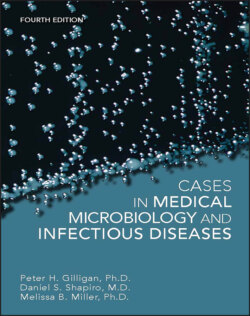Читать книгу Cases in Medical Microbiology and Infectious Diseases - Melissa B. Miller - Страница 19
Wet mounts
ОглавлениеThe wet mount technique is extremely simple to perform. As the name implies, the clinical specimen is usually mixed with a small volume of saline, covered with a glass coverslip, and examined microscopically. It is most commonly utilized to examine discharges from the female genital tract for the presence of yeasts or the parasite Trichomonas vaginalis. Wet mounts are also used to make the diagnosis of oral thrush, which is caused by the yeast Candida albicans. Using a special microscopic technique—dark-field microscopy—scrapings from genital ulcers and certain skin lesions can be examined for the spirochete Treponema pallidum, the organism that causes syphilis. This technique is not particularly sensitive but is highly specific in the hands of an experienced microscopist. It is typically done in STI clinics where large numbers of specimens are available, enabling the microscopist to maintain his or her skill in detecting this organism.
The wet mount can be modified by replacing a drop of saline with a drop of a 10% KOH solution to a clinical specimen. This technique is used to detect fungi primarily in sputum or related respiratory tract specimens, skin scrapings, and tissues. The purpose of the KOH solution is to “clear” the background by “dissolving” tissue and bacteria, making it easier to visualize the fungi.
Figure 1a
Figure 1b
Figure 2
Figure 3
Figure 4
Figure 5
Another modification of the wet mount is to mix a drop of 5% Lugol’s iodine solution with feces. This stains any protozoans or eggs of various worms that may be present in the stool, making them easier to see and identify.
